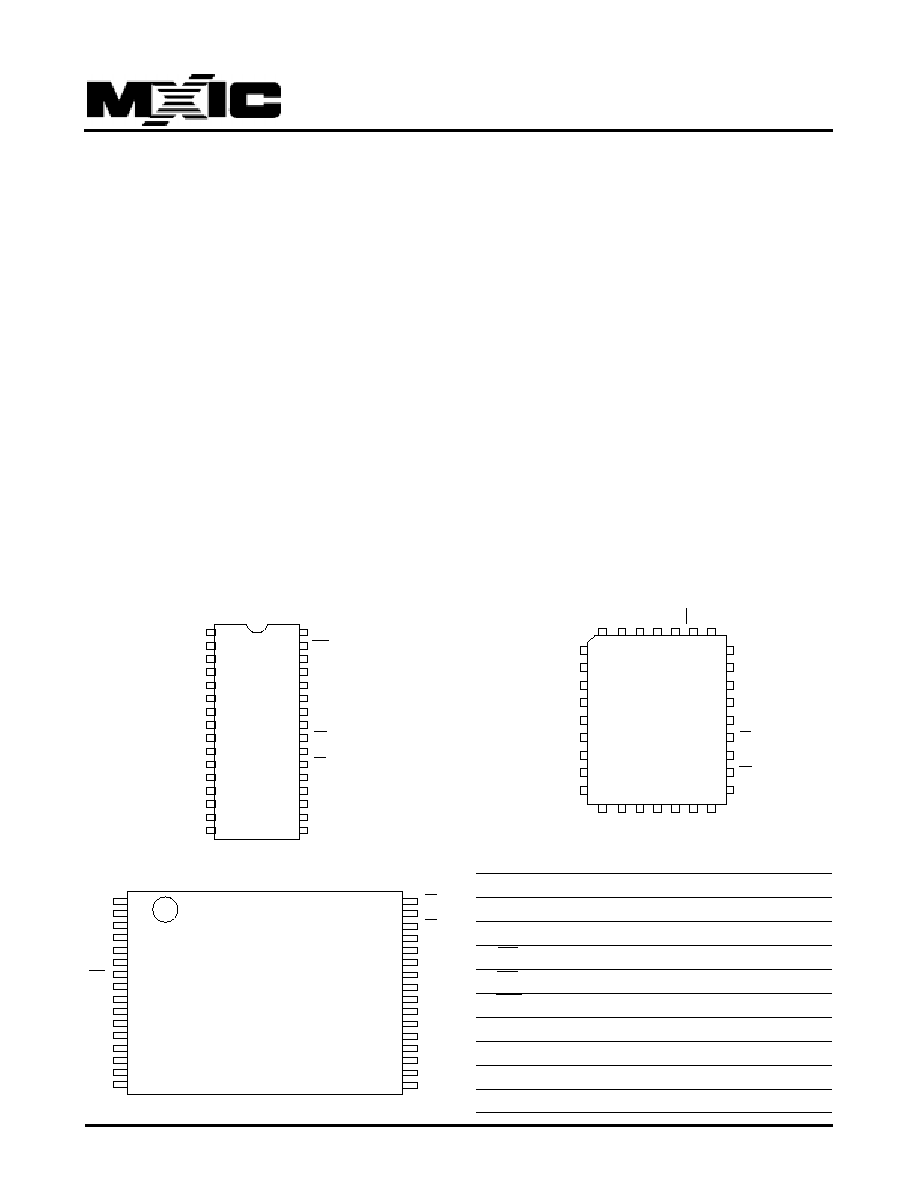
1
PIN DESCRIPTION
REV. 0.8, NOV. 20, 2002
P/N: PM0765
FEATURES
∑
256Kx 8 organization
∑
Single +5V power supply
∑
+12V programming voltage
∑
Fast access time:90/100/120/150 ns
∑
Totally static operation
∑
Completely TTL compatible
∑
Operating current:30mA
∑
Standby current: 100uA
∑
Chip erase time: 1 (typ.)
∑
Chip program time: 12.5 (typ.)
∑
50 minimum erase/program cycles
∑
Typical fast programming cycle duration 10us/byte
∑
Package type:
- 32 pin plastic DIP
- 32 pin PLCC
- 32 pin TSOP
- 32 pin SOP
PIN CONFIGURATIONS
32 PDIP/SOP
32 PLCC
SYMBOL
PIN NAME
A0~A17
Address Input
Q0~Q7
Data Input/Output
CE
Chip Enable Input
OE
Output Enable Input
WE
Write Enable Input
VPP
Program Supply Voltage
NC
No Internal Connection
VCC
Power Supply Pin (+5V)
GND
Ground Pin
MX26C2000B
2M-BIT [256K x 8] CMOS
MULTIPLE-TIME-PROGRAMMABLE-EPROM
ADVANCE INFORMATION
MX26C2000B
1
2
3
4
5
6
7
8
9
10
11
12
13
14
15
16
VPP
A16
A15
A12
A7
A6
A5
A4
A3
A2
A1
A0
Q0
Q1
Q2
GND
32
31
30
29
28
27
26
25
24
23
22
21
20
19
18
17
VCC
WE
A17
A14
A13
A8
A9
A11
OE
A10
CE
Q7
Q6
Q5
Q4
Q3
1
4
5
9
13
14
17
20
21
25
29
32
30
A14
A13
A8
A9
A11
OE
A10
CE
Q7
A7
A6
A5
A4
A3
A2
A1
A0
Q0
Q1
Q2
GND
Q3
Q4
Q5
Q6
A12
A15
A16
VPP
VCC
WE
A17
MX26C2000B
32 TSOP
A11
A9
A8
A13
A14
A17
WE
VCC
VPP
A16
A15
A12
A7
A6
A5
A4
1
2
3
4
5
6
7
8
9
10
11
12
13
14
15
16
OE
A10
CE
Q7
Q6
Q5
Q4
Q3
GND
Q2
Q1
Q0
A0
A1
A2
A3
32
31
30
29
28
27
26
25
24
23
22
21
20
19
18
17
MX26C2000B
GENERAL DESCRIPTION
The MX26C2000B is a 5V only, 2M-bit, MTP EPROM
TM
(Multiple Time Programmable Read Only Memory). It is
organized as 256K words by 8 bits per word, operates
from a single + 5 volt supply, has a static standby mode,
and features fast single address location programming.
All programming signals are TTL levels, requiring a single
pulse. It is design to be programmed and erased by an
EPROM programmer or on-board. The MX26C2000B
supports a intelligent fast programming algorithm which
can result in programming time of less than one minute.
This MTP EPROM
TM
is packaged in industry standard 32
pin dual-in-line packages, 32 lead PLCC, 32 lead SOP
and 32 lead TSOP packages.

2
REV. 0.8, NOV. 20, 2002
P/N: PM0765
MX26C2000B
BLOCK DIAGRAM
CONTROL
INPUT
LOGIC
PROGRAM/ERASE
HIGH VOLTAGE
WRITE
STATE
MACHINE
(WSM)
STATE
REGISTER
MX26C2000B
FLASH
ARRAY
X-DECODER
ADDRESS
LATCH
AND
BUFFER
Y-PASS GATE
Y
-DECODER
ARRAY
SOURCE
HV
COMMAND
DATA
DECODER
COMMAND
DATA LATCH
I/O BUFFER
PGM
DATA
HV
PROGRAM
DATA LATCH
SENSE
AMPLIFIER
Q0-Q7
A0-A17
CE
OE
WE

3
REV. 0.8, NOV. 20, 2002
P/N: PM0765
MX26C2000B
FUNCTIONAL DESCRIPTION
When the MX26C2000B is delivered, or it is erased, the
chip has all 2000K bits in the "ONE", or HIGH state.
"ZEROs" are loaded into the MX26C2000B through the
procedure of programming.
ERASE ALGORITHM
The MX26C2000B do not required preprogramming
before an erase operation. The erase algorithm is a close
loop flow to simultaneously erase all bits in the entire
array. Erase operation starts with the initial erase
operation. Erase verification begins at address 0000H
by reading data FFH from each byte. If any byte fails
to erase. the entire chip is reerased. to a maximum for
30 pulse counts of 100ms duration for each pulse. The
maximum cumulative erase time is 3s. However. the
device is usually erased in no more than 3 pulses. Erase
verification time can be reduced by storing the address
of the last byte that failed. Following the next erase
operation verification may start at the stored address
location. JEDEC standard erase algorithm can also be
used. But erase time will increase by performing the
unnecessary preprogramming.
PROGRAM ALGORITHM
The device is programmed byte by byte. A maximum
of 25 pulses. each of 10us duration is allowed for each
byte being programmed. The byte may be programmed
sequentially or by random. After each program pulse,
a program verify is done to determine if the byte has
been successfully programmed.
Programming then proceeds to the next desired byte
location. JEDEC standard program algorithms can be
used.
RESET
The Reset command initializes the
MTP EPROM
TM
device to the Read mode. In addition, it also provides the
user with a safe method to abort any device operation
(including program or erase). The Reset command must
be written two consecutive times after the set-up Program
command (40H). This will safely abort any previous
operation and initialize the device to the Read mode.
The set-up Program command (40H) is the only command
that requires a two sequence reset cycle. The first Reset
command is interpreted as program data. How ever, FFH
data is considered null data during programming operations
(memory cells are only programmed from logica "1" to
"0". The second Reset command safely aborts the
programming operation and resets the device to the
Read mode.
This detailed information is for your reference. It may
prove esier to always issue the Reset command two
consecutive times. This eliminates the need to determine
if you are in the set-up Program state or not.
SET-UP PROGRAM/PROGRAM
A three-step sequence of commands is required to
perform a complete program operation: Set Up Program-
Program-Program Verify. The device is bulk erased and
byte by byte programming. The command 40H is written
to the command register to initiate Set Up Program
operation. Address and data to be programmed into the
byte are provided on the second WE pulse. Addresses
are latched on the falling edge of the WE pulse, data are
latched on the rising edge of the WE pulse. Program
operation begins on the rising edge of the second WE
pulse, and terminate of the next rising edge of the WE
pulse. Refer to AC Characteristics and Waveforms for
specific timing parameters.
COMMAND REGISTER
When high voltage is applied to V
PP
the command
register is enabled. Read, write, standby, output disable
modes are available. The read, erase, erase verify,
program, program verify and Device ID are accessed via
the command register. Standard microprocessor write
timings are used to input a command to the register. This
register serves as the input to an internal state machine
which controls the operation mode of the device. An
internal latch is used for write cycles, addresses and
data for programming and erase operations.
NO INTEGRATED STOP TIMER FOR ERASE
Leading industry flash technology requires a stop timer
built into the flash chip to prevent the memory cells from
going into depletion due to over erase. The 2 Mbit MTP

4
REV. 0.8, NOV. 20, 2002
P/N: PM0765
MX26C2000B
EPROM
TM
is built on an innovative cell concept in which
over erasing the memory cell is impossible.
DATA WRITE PROTECTION
The design of the device protects against accidental
erasure or programming. The internal state machine is
automatically reset to the read mode on power-up. Using
control register architecture, alteration of memory can
only occur after completion of proper command
sequences. The command register is only active when V
PP
is at high voltage. when V
PP
= V
PPL
, the device defaults
to the Read Mode. Robust design features prevent
inadvertent write cycles resulting from V
CC
power-up and
power-down transitions or system noise. To avoid initiation
of write cycle during V
CC
power-up, a write cycle is locked
out for V
CC
less than 4V. The two- command program and
erase write sequence to the command register provide
additional software protection against spurious data
changes.
PROGRAM VERIFY MODE
Verification should be performed on the programmed bits
to determine that they were correctly programmed.
Verification should be performed with OE and CE, at
VIL, WE at VIH, and VPP at its programming voltage.
ERASE VERIFY MODE
Verification should be performed on the erased chip to
determine that the whole chip(all bits) was correctly
erased. Verification should be performed with OE and
CE at VIL, WE at VIH, and VCC = 5V, VPP = 12.5V
AUTO IDENTIFY MODE
The auto identify mode allows the reading out of a binary
code from MTP EPROM that will identify its
manufacturer and device type. This mode is intended
for use by programming equipment for the purpose of
automatically matching the device to be programmed
with its corresponding programming algorithm. This
mode is functional in the 25
∞
C
±
5
∞
C ambient temperature
range that is required when programming the
MX26C2000B.
To activate this mode, the programming equipment must
force 12.0
±
0.5 V on address line A9 of the device.
Two identifier bytes may then be sequenced from the
device outputs by toggling address line A0 from VIL to
VIH. All other address lines must be held at VIL during
auto identify mode.
Byte 0 ( A0 = VIL) represents the manufacturer code,
and byte 1 (A0 = VIH), the device identifier code. For
the MX26C2000B, these two identifier bytes are given
in the Mode Select Table. All identifiers for manufacturer
and device codes will possess odd parity, with the MSB
(DQ7) defined as the parity bit.
READ MODE
The MX26C2000B has two control functions, both of
which must be logically satisfied in order to obtain data
at the outputs. Chip Enable (CE) is the power control
and should be used for device selection. Output Enable
(OE) is the output control and should be used to gate
data to the output pins, independent of device selection.
Assuming that addresses are stable, address access
time (tACC) is equal to the delay from CE to output (tCE).
Data is available at the outputs tOE after the falling edge
of OE, assuming that CE has been LOW and addresses
have been stable for at least tACC - tOE.
STANDBY MODE
The MX26C2000B has a CMOS standby mode which
reduces the maximum VCC current to 100 uA. It is
placed in CMOS standby when CE is at VCC
±
0.3 V.
The MX26C2000B also has a TTL-standby mode which
reduces the maximum VCC current to 1.5 mA. It is
placed in TTL-standby when CE is at VIH. When in
standby mode, the outputs are in a high-impedance
state, independent of the OE input.
SYSTEM CONSIDERATIONS
During the switch between active and standby
conditions, transient current peaks are produced on the
rising and falling edges of Chip Enable. The magnitude
of these transient current peaks is dependent on the
output capacitance loading of the device. At a minimum,
a 0.1 uF ceramic capacitor (high frequency, low inherent
inductance) should be used on each device between
VCC and GND to minimize transient effects. In addition,
to overcome the voltage drop caused by the inductive

5
REV. 0.8, NOV. 20, 2002
P/N: PM0765
MX26C2000B
Table 1: BUS OPERATIONS
Mode
VPP(1)
A0
A9
CE
OE
WE
Q0~Q7
Read
VPPL
A0
A9
VIL
VIL
VIH
Data Out
READ-ONLY
Output Disable
VPPL
X
X
VIL
VIH
VIH
Tri-State
MODE
Standby
VPPL
X
X
VIH
X
X
Tri-State
Manufacturer Identification
VPPL
VIL
VID(2) VIL
VIL
VIH
Data=C2H
Device Identification
VPPL
VIH
VID(2) VIL
VIL
VIH
Data=C3H
Read
VPPH
A0
A9
VIL
VIL
VIH
Data Out(3)
COMMAND
Output Disable
VPPH
X
X
VIL
VIH
VIH
Tri-State
MODE
Standby(4)
VPPH
X
X(5)
VIH
X
X
Tri-State
Program
VPPH
A0
A9
VIL
VIH
VIL
Data Inb
Note:
1. Refer to DC Characteristics. When VPP=VPPL memory contents can be read but not written or erased.
2. VID is the intelligent identifier high voltage. Refer to DC Characteristics.
3. Read operations with VPP=VPPH may access array data or the intelligent identifier codes.
4. With VPP at high voltage the standby current equals ICC+IPP(standby).
5. Refer to Table 2 for vaild data-in during a write operation.
6. X can be VIL or VIH.
effects of the printed circuit board traces on EPROM
arrays, a 4.7 uF bulk electrolytic capacitor should be
used between VCC and GND for each of the eight
devices. The location of the capacitor should be close
to where the power supply is connected to the array.
OUTPUT DISABLE
Output is disabled when OE is at logre high. When in
output disabled all circuitry is enabled. Except the output
pins are in a high impedance state(TRI-ATATE).

6
REV. 0.8, NOV. 20, 2002
P/N: PM0765
MX26C2000B
COMMAND MODE
The 2 Mbit MTP EPROM
TM
is in Command mode when
high voltage V
PPH
is applied to the V
PP
pin. In this state the
available functions are Read, Program, Program Verify,
Eraseand Erase Verify. Reset are selected by writing
commands to the input register. Data from the register are
input to the state machine. The output from the state
machine determines the function of the device. The
command register serves as a latch to store data for
executing commands. It does not occupy address- able
memory location. Standard microprocessor write timing is
used. Table 2 defines the register commands. The
command register is written by bringing WE to a logic-low
Level (V
IL
), while CE is low. Addresses are latched on the
falling edge of WE, while data is latched on the rising edge
of the WE pulse.
Standby and Output disable functions are the same as in
Read Mode, controlled by CE and OE. If the device is
deselected during erasure, programming, or erase/program
verification, the device draws active current until the
operations terminate.
READ COMMAND
To read memory content, write 00H into the command
register while high voltage is applied to
V
PP
pin (V
PP
= V
PPH
). Microprocessor read cycle retrieves
the data . The device remains enable for read until the data
in the command register are altered. The device is default
in read mode when power up. This is to ensure no
accidental alteration of the memory occurs during power
transition. Refer to AC Read Characteristics and Waveforms
for specific timing parameters.
SET UP ERASE/ERASE
Preprogram operation is not required prior to the erase
operation. A sequence of commands is required to perform
a complete erase operation: set up erase, erase, and
erase verify. High voltage is applied to the V
PP
pin
(V
PP
=V
PPH
). The command 20H is written to the command
register to initiate the set-up erase mode.
ERASE OPERATION
The same command, 20H, is again written to the
command register. This second command starts bulk
erase operation. The two-step command prevents
accidental alteration to memory array. Erase operation
starts with the rising edge of the WE pulse and
terminates with the rising edge of the next WE pulse,
which in this case is the erase verify command.
ERASE VERIFY
Each erase operation is followed by an erase verify. The
command A0H is written into the command register. The
address of the bytes to be verified is supplied with the
command. The address is latched on the falling edge of
the WE pulse. A reading FFH is returned to confirm all
bits in the byte are erased. This sequence of Set Up
Erase- Erase continues for each address until FFH is
returned. This indicates the entire memory array is
erased and completes the operation. Erase verify
operation starts at address 0000H and ends at the last
address. Maximum erase pulse duration for the 2Mbit
MTP EPROM
TM
is 100ms with a maximum 30 pulses.
Refer to AC Characteristics and Waveforms for specific
timing parameters.

7
REV. 0.8, NOV. 20, 2002
P/N: PM0765
MX26C2000B
PROGRAMMING ALGORITHM FLOW CHART
Start
Programming
Programming
Completed
Apply VPPH
Write Read CMD
Increment Address
Apply VPPL
Programming
Error
Apply VPPL
PLSCNT=0
Write Set-up Program CMD
YES
YES
NO
NO
NO
Write Program Cmd(A/D)
Time Out 10us
Time out 6us
Read Data From Device
Write Program Verify Cmd
Verify Data ?
Inc PLSNT=25 ?
YES
Last Address ?

8
REV. 0.8, NOV. 20, 2002
P/N: PM0765
MX26C2000B
ERASE ALGORITHM FLOW CHART
Start
Erasure
Erasure
Completed
Apply VPPH
Write Read CMD
Increment Address
Apply VPPL
Erasure
Error
Apply VPPL
Address=00H
PLSCNT=0
Write Set-up Erase and
Erase Cmd
YES
YES
NO
NO
NO
Time Out 100ms
Time out 6us
Read Data From Device
Write Erase Verify Cmd
Data=FFH ?
Inc PLSNT=30 ?
YES
Last Address ?
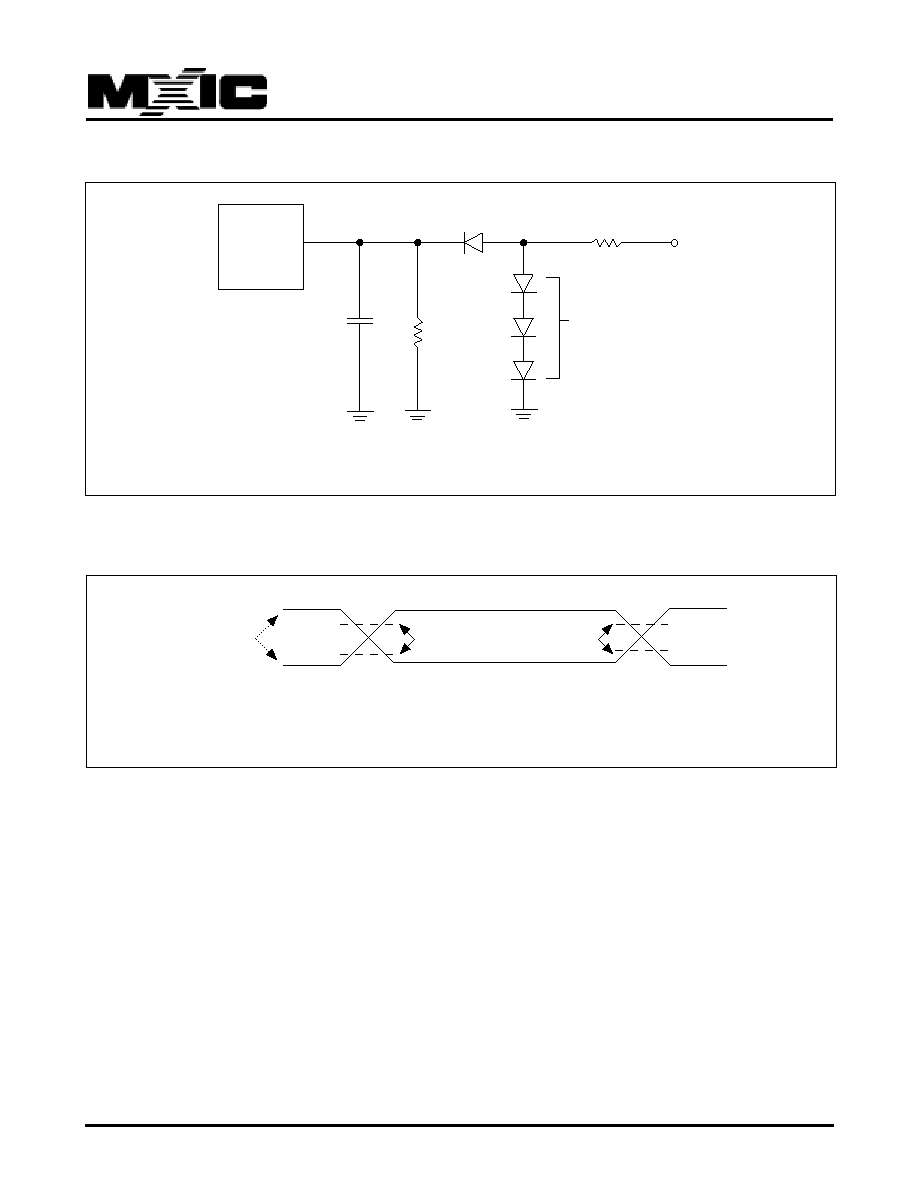
9
REV. 0.8, NOV. 20, 2002
P/N: PM0765
MX26C2000B
SWITCHING TEST CIRCUITS
SWITCHING TEST WAVEFORMS
DEVICE
UNDER
TEST
DIODES = IN3064
OR EQUIVALENT
CL = 100 pF including jig capacitance
6.2K ohm
1.8K ohm
+5V
CL
2.0V
0.8V
TEST POINTS
INPUT
2.0V
0.8V
OUTPUT
AC TESTING: AC driving levels are 2.4V/0.4V for commercial grade.
Input pulse rise and fall times are equal to or less than 10ns.
AC driving levels

10
REV. 0.8, NOV. 20, 2002
P/N: PM0765
MX26C2000B
NOTICE:
Stresses greater than those listed under ABSOLUTE
MAXIMUM RATINGS may cause permanent damage to
the device. This is a stress rating only and functional
operation of the device at these or any other conditions
above those indicated in the operational sections of this
specification is not implied. Exposure to absolute
maximum rating conditions for extended period may
affect reliability.
NOTICE:
Specifications contained within the following tables are
subject to change.
ABSOLUTE MAXIMUM RATINGS
RATING
VALUE
Ambient Operating Temperature -40
o
C to 85
o
C
Storage Temperature
-65
o
C to 125
o
C
Applied Input Voltage
-0.5V to 7.0V
Applied Output Voltage
-0.5V to VCC + 0.5V
VCC to Ground Potential
-0.5V to 7.0V
A9 & VPP
-0.5V to 13.5V
CAPACITANCE
TA = 25
o
C, f = 1.0 MHz (Sampled only)
SYMBOL
PARAMETER
TYP.
MAX.
UNIT
CONDITIONS
CIN
Input Capacitance
8
12
pF
VIN = 0V
COUT
Output Capacitance
8
12
pF
VOUT = 0V
CVPP
VPP Capacitance
18
25
pF
VPP = 0V
MX26C2000B
-90
-100
-120
-150
Operating Temperature Industrial
-40
∞
C to 85
∞
C
-40
∞
C to 85
∞
C
-40
∞
C to 85
∞
C
-40
∞
C to 85
∞
C
Vcc Power Supply
5V
±
10%
5V
±
10%
5V
±
10%
5V
±
10%
DC/AC OPERATING CONDITION FOR READ OPERATION
DC CHARACTERISTICS
TA = -45
∞
C ~ 85
∞
C, VCC=5V
±
10%
SYMBOL
PARAMETER
MIN.
MAX.
UNIT CONDITIONS
VIL
Input Low Voltage
-0.3
0.8
V
VIH
Input High Voltage
2.0
VCC + 0.5
V
VOL
Output Low Voltage
0.4
V
IOL = 2.1mA, VCC=VCC MIN
VOH
Output High Voltage
2.4
V
IOH = -0.4mA
ICC1
VCC Active Current
30
mA
CE = VIL, OE=VIH, f=5MHz
ISB
VCC Standby Current (CMOS)
100
uA
CE=VCC+0.2V, VCC=VCC MAX
ISB
VCC Standby Current (TTL)
1.5
mA
CE=VIH, VCC=VCC MAX
IPP
VPP Read Current
100
uA
CE = OE = VIL, VPP = 5.5V
IPP2
VPP Supply Current
30
mA
CE=WE=VIL, OE=VIH
(Program/Erase)
ILI
Input Leakage Current
-10
10
uA
VIN = 0 to 5.5V
ILO
Output Leakage Current
-10
10
uA
VOUT = 0 to 5.5V
VCC1
Fast Programming Supply Voltage
6.0
6.5
V
VPP1
Fast Programming Voltage
12.5
13.0
V

11
REV. 0.8, NOV. 20, 2002
P/N: PM0765
MX26C2000B
AC RAED CHARACTERISTICS OVER OPERATING RANGE WITH VPP=VCC
Symbol
Parameter
90
100
120
150
Unit
Jeded STD
MIN
MAX MIN
MAX MIN
MAX MIN MAX
tAVAV TRC
Read Cycle Time
90
100
120
150
ns
tELQV TCE
CE Access Time
0
90
0
100
0
120
0
150
ns
tAVQV TACC
Address Access Time
0
90
0
100
0
120
0
150
ns
tGLQV TOE
OE Access Time
0
40
0
45
0
50
0
65
ns
tELQX TLZ
CE to Output in Low Z(Note 1)
0
0
0
0
ns
tEHQZ TDF
Chip Disable to Output in High Z(Note 2) 0
30
0
35
0
35
0
50
ns
tGLQX TOLZ
OE to Output in Low Z (Note 1)
0
0
0
0
ns
tGHQZ TDF
Output Disable to Output in High Z
0
30
0
35
0
35
0
50
ns
(Note 1)
tAXQX TOH
Output Hold from Address, CE or OE,
0
0
0
0
ns
change
tWHGL TWHGL Write Recovery Time Before Read
6
6
6
6
us
tVCS
TVCS
VCC Setup Time to Valid Read (Note 2)
50
50
50
50
us
Note:
1. Sampled: not 100% tested.
2. Guaranteed by design. not tested.

12
REV. 0.8, NOV. 20, 2002
P/N: PM0765
MX26C2000B
AC CHARACTERISTICS - WRITE/ERASE/PROGRAM OPERATIONS
Symbol
Parameter
90
100
120
150
Unit
JEDED
STD
MIN MAX MIN
MAX MIN MAX MIN MAX
tAVAV
TWC
Write Cycle Time (Note 3)
90
100
120
150
ns
tAVWL
TAS
Address Setup Time
0
0
0
0
ns
tWLAX
TAH
Address Hold Time
40
40
40
40
ns
tDVWH
TDS
Data Setup Time
40
40
40
40
ns
tWHDX
TDH
Data Hold Time
10
10
10
10
ns
tWHGL
TWR
Write Recovery Time Before Read
6
6
6
6
us
tGHWL
TDES Read Recovery Time Before Write
0
0
0
0
us
tELWL
tCS
CE Setup Time Before Write
0
0
0
0
ns
tWHEH
tCH
CE Hold Time
0
0
0
0
ns
tWLWH
tWP
Write Pulse Width
50
50
50
50
ns
tWHWL
tWPH Write Pulse Width High
20
20
20
20
ns
tWHWH1
Duration of Programming Operation
10
10
10
10
us
(Note2)
tWHWH2
Duration of Erase Operation(Note2)
100
100
100
100
ms
tVPEL
VPP Setup Time to Chip Enable Low
1
1
1
1
us
(Note 3)
tVCS
VCC Setup Time to Chip Enable Low
50
50
50
50
us
(Note 3)
tVPPR
VPP Rise Time (Note 3) 90% VPPH
500
500
500
500
ns
tVPPF
VPP Fall Time (Note 3) 10% VPPH
500
500
500
500
ns
Note:
1. Read timing characteristics during read/write operations are the same as during read-only operations. Refer to
AC Characteristics for Read Only Operations.
2. Maximum pulse widths not required because the on-chip program/erase circuitry will terminate the pulse widths
internally on the device.
3. Not 100% tested.
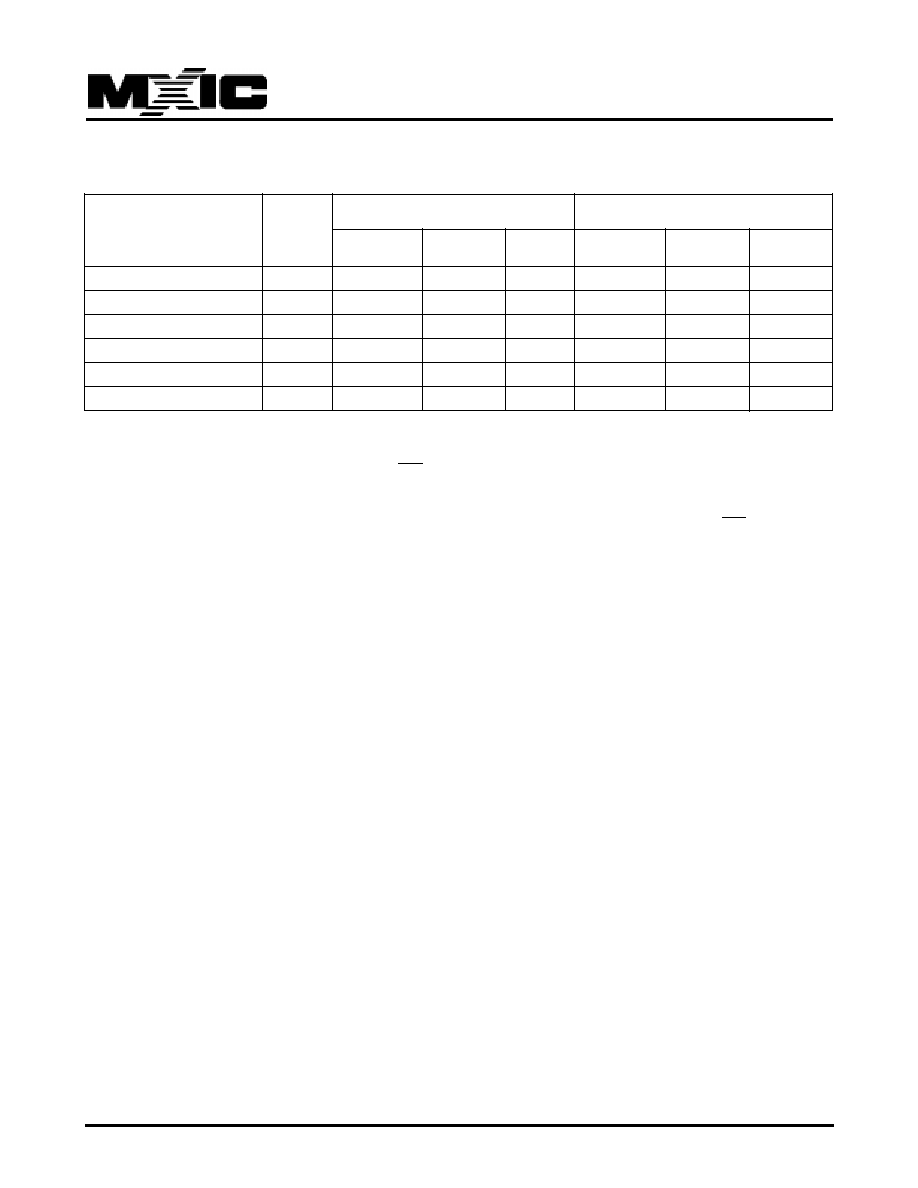
13
REV. 0.8, NOV. 20, 2002
P/N: PM0765
MX26C2000B
Table 2: Command Definitions
Command
Bus
First Bus Cycle
Second Bus Cycle
Cycles.
Req
Operation
Address
1
Data
2
Operation
Address
1
Data
2
Read Memory
1
Write
X
00H
Setup Erase/Erase
2
Write
X
20H
Write
X
20H
Erase Verify
2
Write
EA
A0H
Read
X
EVD
Setup Program/Program
2
Write
X
40H
Write
PA
PD
Program Verify
2
Write
X
C0H
Read
X
PVD
Reset
2
Write
X
FFH
Write
X
FFH
1 EA=Erase Address: address of memory location to be read during erase verify.
PA=Program Address: address of memory location to be Programmed.
Address are latched on the falling edge of the WE pulse.
2 EVD=Erase Verify Data: data read from location EA during erase verify.
PD=Program Data: data to be programmed at location PA. Data is latched on the rising edge of WE.
PVD=Program Verify Data: data read from location PA during program verify. PA is latched on the Program
command.

14
REV. 0.8, NOV. 20, 2002
P/N: PM0765
MX26C2000B
AC WAVEFORMS FOR READ OPERATIONS
Address
CE
OE
WE
Data
VCC
tAXQX(tOH)
tGHQZ(tDF)
tEHQZ(tDF)
tAVAV(tRC)
tGLQV(tOE)
tELQX(tLZ)
tGLQX(tOLZ)
tELQV(tCE)
tWHGL
tVCS
tAVQV(tACC)
High Z
5.0V
0V
Power-Up Standby
Device and
Address Selection
Outputs
enabled
Data Valid
Standby Power-Up
High Z
Addresses Stable
Output Valid

15
REV. 0.8, NOV. 20, 2002
P/N: PM0765
MX26C2000B
AC WAVEFORMS FOR ERASE OPERATIONS
Addresses
CE
OE
WE
Data
VCC
tAVAV(tWC)
tAVWL(tAS)
tELWL(tCS)
tWHEH(tCH)
tGHWL(tDES)
tWLWH(tWP)
tWHWL(tWPH)
tVCS
tVPEL
tDVWH(tDS)
tWHDX(tDH)
tAVAV(tRC)
tEHQZ(tDF)
tGHQZ(tDF)
tGLQX(tOLZ)
tGLQV(tOE)
tAXQX(tOH)
tELQX(tLZ)
tELQV(tCE)
tAVWL(tAS)
tWHWH1
tWHGL
tWLAX(tAH)
Power-Up
Standby
Setup Program
Program Command
Latch Program Address
and Data
Programming
Verify
Command
Programming
Verification
Standby
Power-Down
DATA
IN=40h
DATA
IN=PD
5V
0V
VPP
VPPH
VPPL
DATA
IN=C0h
VALID DATA
OUT

16
REV. 0.8, NOV. 20, 2002
P/N: PM0765
MX26C2000B
AC WAVEFORMS FOR PROGRAMMING OPERATIONS
Addresses
CE
OE
WE
Data
VCC
tAVAV(tWC)
tAVWL(tAS)
tELWL(tCS)
tWHEH(tCH)
tGHWL(tDES)
tWLWH(tWP)
tWHWL(tWPH)
tVCS
tVPEL
tDVWH(tDS)
tWHDX(tDH)
tAVAV(tRC)
tEHQZ(tDF)
tGHQZ(tDF)
tGLQX(tOLZ)
tGLQV(tOE)
tAXQX(tOH)
tELQX(tLZ)
tELQV(tCE)
tAVWL(tAS)
tWHWH1
tWHGL
tWLAX(tAH)
Power-Up
Standby
Setup Program
Program Command
Latch Address
and Data
Programming
Verify
Command
Programming
Verification
Standby
Power-Down
DATA
IN=20h
DATA
IN=20h
5V
0V
VPP
VPPH
VPPL
DATA
IN=C0h
VALID DATA
OUT

17
REV. 0.8, NOV. 20, 2002
P/N: PM0765
MX26C2000B
ORDERING INFORMATION
PLASTIC PACKAGE
PART NO.
ACCESS TIME(ns)
OPERATING
STANDBY
OPERATING
PACKAGE
Current MAX.(mA)
Current MAX.(uA)
TEMPERATURE
MX26C2000BPC-90
90
30
100
0
∞
C to 70
∞
C
32 Pin DIP
MX26C2000BQC-90
90
30
100
0
∞
C to 70
∞
C
32 Pin PLCC
MX26C2000BMC-90
90
30
100
0
∞
C to 70
∞
C
32 Pin SOP
MX26C2000BTC-90
90
30
100
0
∞
C to 70
∞
C
32 Pin TSOP
MX26C2000BPC-10
100
30
100
0
∞
C to 70
∞
C
32 Pin DIP
MX26C2000BQC-10
100
30
100
0
∞
C to 70
∞
C
32 Pin PLCC
MX26C2000BMC-10
100
30
100
0
∞
C to 70
∞
C
32 Pin SOP
MX26C2000BTC-10
100
30
100
0
∞
C to 70
∞
C
32 Pin TSOP
MX26C2000BPC-12
120
30
100
0
∞
C to 70
∞
C
32 Pin DIP
MX26C2000BQC-12
120
30
100
0
∞
C to 70
∞
C
32 Pin PLCC
MX26C2000BMC-12
120
30
100
0
∞
C to 70
∞
C
32 Pin SOP
MX26C2000BTC-12
120
30
100
0
∞
C to 70
∞
C
32 Pin TSOP
MX26C2000BPC-15
150
30
100
0
∞
C to 70
∞
C
32 Pin DIP
MX26C2000BQC-15
150
30
100
0
∞
C to 70
∞
C
32 Pin PLCC
MX26C2000BMC-15
150
30
100
0
∞
C to 70
∞
C
32 Pin SOP
MX26C2000BTC-15
150
30
100
0
∞
C to 70
∞
C
32 Pin TSOP
MX26C2000BPI-90
90
30
100
-40
∞
C to 85
∞
C
32 Pin DIP
MX26C2000BQI-90
90
30
100
-40
∞
C to 85
∞
C
32 Pin PLCC
MX26C2000BMI-90
90
30
100
-40
∞
C to 85
∞
C
32 Pin SOP
MX26C2000BTI-90
90
30
100
-40
∞
C to 85
∞
C
32 Pin TSOP
MX26C2000BPI-10
100
30
100
-40
∞
C to 85
∞
C
32 Pin DIP
MX26C2000BQI-10
100
30
100
-40
∞
C to 85
∞
C
32 Pin PLCC
MX26C2000BMI-10
100
30
100
-40
∞
C to 85
∞
C
32 Pin SOP
MX26C2000BTI-10
100
30
100
-40
∞
C to 85
∞
C
32 Pin TSOP
MX26C2000BPI-12
120
30
100
-40
∞
C to 85
∞
C
32 Pin DIP
MX26C2000BQI-12
120
30
100
-40
∞
C to 85
∞
C
32 Pin PLCC
MX26C2000BMI-12
120
30
100
-40
∞
C to 85
∞
C
32 Pin SOP
MX26C2000BTI-12
120
30
100
-40
∞
C to 85
∞
C
32 Pin TSOP
MX26C2000BPI-15
150
30
100
-40
∞
C to 85
∞
C
32 Pin DIP
MX26C2000BQI-15
150
30
100
-40
∞
C to 85
∞
C
32 Pin PLCC
MX26C2000BMI-15
150
30
100
-40
∞
C to 85
∞
C
32 Pin SOP
MX26C2000BTI-15
150
30
100
-40
∞
C to 85
∞
C
32 Pin TSOP

18
REV. 0.8, NOV. 20, 2002
P/N: PM0765
MX26C2000B
PACKAGE INFORMATION

19
REV. 0.8, NOV. 20, 2002
P/N: PM0765
MX26C2000B
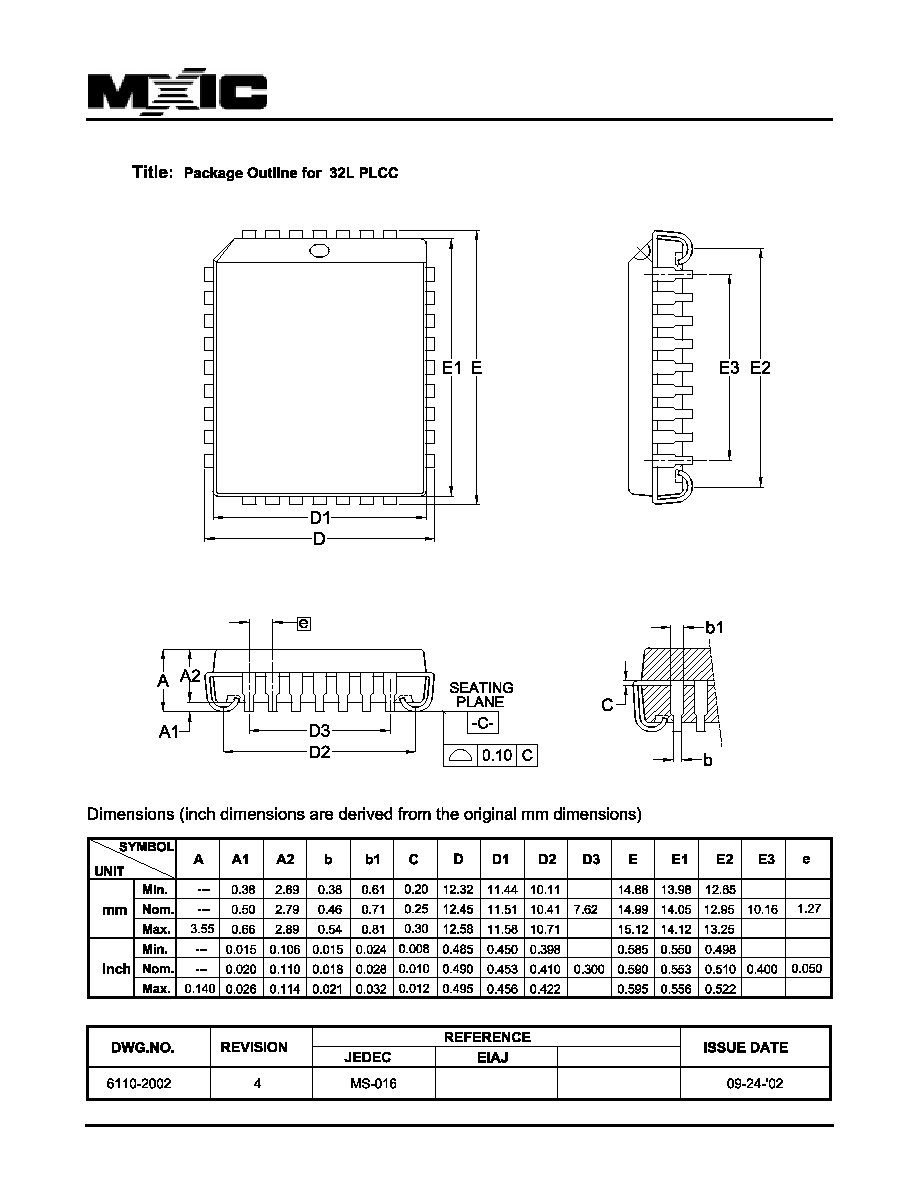
20
REV. 0.8, NOV. 20, 2002
P/N: PM0765
MX26C2000B
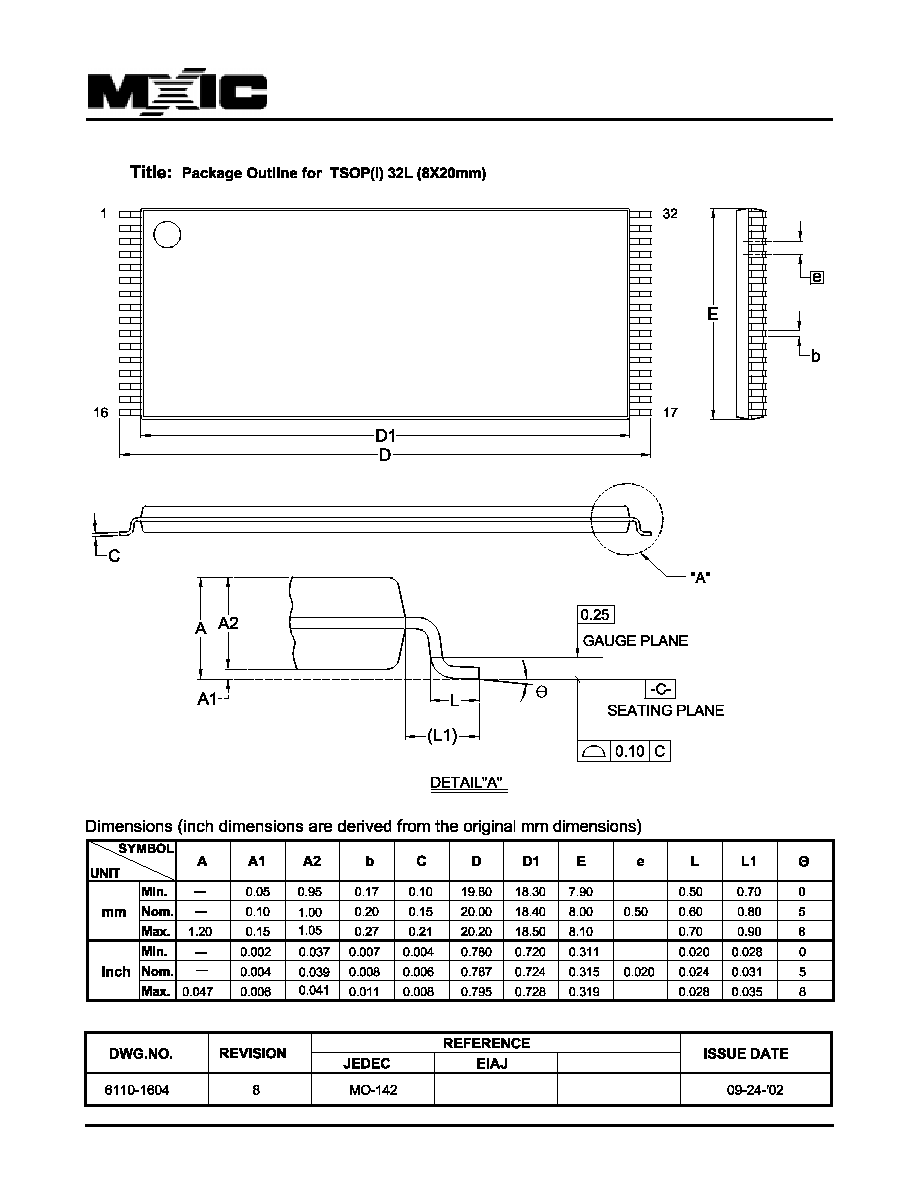
21
REV. 0.8, NOV. 20, 2002
P/N: PM0765
MX26C2000B

22
REV. 0.8, NOV. 20, 2002
P/N: PM0765
MX26C2000B
Revision History
Revision No. Description
Page
Date
0.1
To Add speed 100ns to MX26C2000B
P1,10,11,12,18 NOV/28/2000
Modify the "DC CHARACTERISTICS" table
P10
0.2
To add erase/program cycle
P1
DEC/18/2000
Changed title from MX26C2000A to MX26C2000B
All
0.3
Change Device ID code from 31H to CFH
P5
DEC/28/2000
0.4
To added 32SOP/TSOP types package and access time 150ns
P1,11,12,17,18 MAR/27/2001
Modify device ID old CFH-->New C3H
P5
Modify read ID method
P4,5,6,13
Modify erase/program cycle from 100 to 50
P1
Modify VCC Standby Current(TTL) from 1mA to 1.5mA
P10
0.5
To added VCC1 & VPP1 to DC Characteristics Table
P10
APR/23/2001
Modify Package Information
P18~21
0.6
To added chip erase time / chip program time
P1
JUL/04/2001
Modify Package Information
P18~21
0.7
Modify the Programming Operations Timing Waveforms
P15
OCT/04/2001
0.8
To modify Package Information
P18~21
NOV/20/2002

MX26C2000B
M
ACRONIX
I
NTERNATIONAL
C
O.,
L
TD.
HEADQUARTERS:
TEL:+886-3-578-6688
FAX:+886-3-563-2888
EUROPE OFFICE:
TEL:+32-2-456-8020
FAX:+32-2-456-8021
JAPAN OFFICE:
TEL:+81-44-246-9100
FAX:+81-44-246-9105
SINGAPORE OFFICE:
TEL:+65-348-8385
FAX:+65-348-8096
TAIPEI OFFICE:
TEL:+886-2-2509-3300
FAX:+886-2-2509-2200
M
ACRONIX
A
MERICA,
I
NC.
TEL:+1-408-453-8088
FAX:+1-408-453-8488
CHICAGO OFFICE:
TEL:+1-847-963-1900
FAX:+1-847-963-1909
http : //www.macronix.com
MACRONIX INTERNATIONAL CO., LTD. reserves the right to change product and specifications without notice.






















